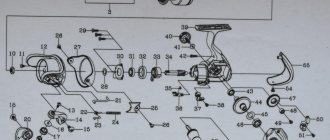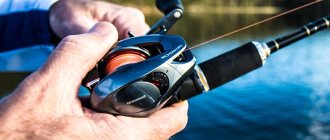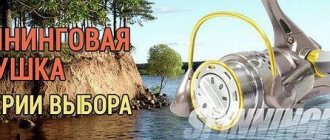As one of the classics of humor said: “The brakes were invented by cowards! And the flies... they have no brakes at all!”
Anyone who has ever tried to fish with casting gear knows firsthand what a “beard” or “runaway” is, as this unpleasant phenomenon is commonly called among multi-fishermen. As soon as it is not called: beard, dash, washcloth, bird's nest and many other expressions, the publication of which is not allowed by the high morality of a cultured fisherman.
How is a dash formed?
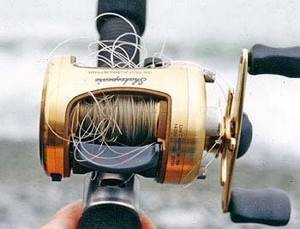
The only reason for the formation of dashes on inertial reels is the difference between the flight speed of the bait and the speed of rotation of the spool. With all the variety of names for this phenomenon, there are simply no other reasons.
When casting with casting gear, the flying bait and the rotating spool, connected by a cord or fishing line, interact with each other. If the speeds are approximately the same, then there is no rush; if the speeds are not coordinated during the casting process, then you are guaranteed a beautiful beard like Santa Claus. The number of runs and runs depends not only on the skill of the fisherman, which comes only with experience, but also on how correctly the brakes in the reel are set.
It so happened that casting bait with a multiplier is usually divided into three stages: the initial (first third), the free flight stage (the second third) and the splashdown stage (the third third is some kind of tautology, but it’s not me who said it, and it’s not for me to change the name). Some people divide it into four parts, but personally I like this division better.
initial stage
When the bait is released into flight, the inertia gained by this bait during the swing is transferred to the previously released spool. In the first third of the cast, the spool accelerates to maximum speed (equal to the flight speed of the bait).
If the cast is made incorrectly, or rather, not smoothly, then we get a dash. It occurs due to a jerk, i.e. uneven acceleration of the bait’s flight, and as a result, a short and sharp impulse transmitted to the spool. The revolutions on the spool in a short period of time (usually a tenth of a second is enough for this) exceed the flight speed of the bait, the cord first unwinds and then winds in the opposite direction, causing the free spool to instantly stop.
Such a beard is fraught with the most severe consequences, such as:
- Shooting bait. Occurs when the breaking load on the cord is exceeded in a short period of time. There are fewer shootings on monofilament lines, since the elongation coefficient in them is much higher than in braids.
- “Putting in” the cord. When the spool suddenly stops, the bait continues to pull the line along with it. If it is strong enough and no shooting occurs, then the upper turns cut between the lower layers. Such a combination of circumstances can lead to mechanical damage to the cord and, as a result, to a decrease in overall strength. When using monofilament materials, penetration occurs much less frequently and line wear is, accordingly, much less. And the reason for this is the same stretchability of the material.
- Impact on bearings. All because of the same high rotation speed and instant stop of the spool, a flying bait, even if it weighs at least 3 grams, creates a compression transverse impact on the bearings on which the spool rotates. The result is premature wear and expensive replacement. And in this case, when a beard forms in the initial stage of casting, the fishing line gives a head start to the braided line. And, again, the only reason for this is... That's right!
It is precisely because of the greater stretch coefficient of monofilament compared to braided cord that it is recommended to learn to work with multiplier tackle with fishing line. It is cheaper and forgives the first mistakes of a beginning cartoonist. And I don’t really feel sorry for her.
Free flight stage
The word “third,” in my opinion, does not quite fit either this stage of casting or the conventional division of the entire process. Simply because the free flight stage is from 50 to 70 percent, if we take the distance from the start of the bait's flight to splashdown as 100%.
At this stage, the occurrence of dashes is minimal, because the rotation speed of the spool and the flight speed of the bait are close to each other. Naturally, different forces act on the bait, such as gravity, wind, loss of speed, therefore the spool must be slowed down. But properly adjusted brake systems cope well with this. But more about them a little later.
Bait splashdown stage
But the speed of the bait’s flight begins to drop significantly - it comes into contact with water. And the spool, due to the well-coordinated operation of the bearings, continues to maintain higher rotation speeds. This is where the inexperienced fisherman again encounters dashes. Why only the inexperienced? Yes, because an experienced one has already learned to work with the thumb of his right/left hand and forcibly brakes the spool.
Yes, here you can avoid the occurrence of overruns only by reducing the rotation speed of the reel with your thumb, because the reel braking systems cannot do that! Elimination of runaways at the final stage of casting can only be achieved experimentally.
Now let’s leave the issue of gaining experience until practical training (this is approximately until April-May) and turn to the technical side of the issue - what are brake systems, how many there are and how they work and are configured.
Multiplier fishing reels: how to use and cast the tackle correctly
We tried to answer the question above: the multiplier coil operates, now let’s look at how to use it. Let us immediately note that when working with a multicast, the cross-section of the line does not affect the casting distance of the tackle.
The cast is made with smooth movements. Unlike inertia-free spinning, a sharp swinging movement is not encouraged here, since there is a possibility of giving the spool excessive acceleration, leading to the formation of a beard. How to use a baitcasting reel with a soap dish, which allows you to work with light baits, including.
The form is held in front of you. Before casting, you must press the lever and hold the drum with your thumb to prevent the line from coming off. We remind you once again that you need to send the equipment forward without excessive acceleration. When the form reaches 50 degrees relative to the reservoir, the forest is released.
During the flight of the bait, the rotation of the spool is somewhat slowed down to avoid possible tangling of the line. To increase the casting distance of the tackle, the bait is lowered 30-40 cm from the tip of the spinning rod.
If you plan to fish with jig baits in a relatively small body of water, the form is equipped with a low-profile multiplier. If the reservoir has a decent depth, a barrel would be more appropriate. For trolling fishing, more powerful reels are selected.
Cartoon brakes
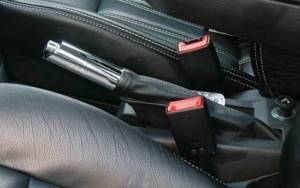
Well, here we smoothly come to the main question of today. The introduction is long, but it will help to understand the main issues of the review.
Just for fun, I counted the number of braking systems present in multiplier reels. The result surprised me at first - from 4 to 6. Isn't it a bit much for such a small device as a cartoon? It turns out, just right. And here's what I counted:
- Axial brake;
- Friction brake;
- Reverse stopper (also considered a braking system);
- Centrifugal brake;
- Magnetic brake;
- DC (Digital Control) system;
- Clicker.
Let's look at each of the listed systems in more detail.
Axial brake
It is not for nothing that the axial brake is number one among all the above mentioned braking systems in inertial coils. The history of the appearance of the axial brake goes back to the first developments of baitcasting reels, namely the “Kentucky” Snyder reel (more information about Snyder reels can be found on the page of the Cartoon Man Diaries, dedicated to the history of the appearance of multipliers). While developing his reel, the engineer was faced with the fact that the spool moved freely to the right and left relative to the body. Changing the length of the axis and further testing led the talented developer to come up with a system for pressing the spool axis, thereby inventing the first axial brake.
In modern multipliers, the function of the axial brake is to regulate the speed of free rotation of the spool. This is achieved by tightening/releasing the pressure of the composite spacer on the spool body. The working stroke of this brake is only a few millimeters, but in a precision (highly accurate) instrument this is quite enough.
With the axial brake fully tightened, the released spool has virtually no free movement and the inertia transmitted when casting the bait is minimized already at the initial stage of casting. Yes, you will cast. And most likely you won’t get a dash. But by reducing the inertia of the spool you will not get any long casting.
With the axle fully loosened, the spool receives minimal resistance on the axle and has a little play (exactly the horizontal movement that Snyder first encountered). The inertia transferred to the spool from the bait during casting has maximum efficiency and accelerates it to maximum speeds. This is very good for long-distance casting, but inexperienced fishermen will have to dash too often. Even in the process of threading the cord through the rings of a spinning rod with a weakened axial brake, the spool winds free meters around itself in the opposite direction.
For beginners, it is recommended to tighten the axial brake so that the released spool stops spinning when the bait reaches the ground. The spinning rod must be in a horizontal plane.
Why is a braking system needed?
Before understanding certain structures, it is necessary to understand their purpose. First of all, you need to understand that we are dealing with an inertial type of reel, and therefore the line coming off when casting from such a reel occurs due to the inertial rotation of the spool. At the moment of casting, a force arises on the line from the abandoned bait, which initiates rotation. It seems that everything is simple - the bait flies and pulls the fishing line behind it from a rotating spool. The danger is that the graph of the decrease in the speed of rotation of the spool, without the use of additional effort, will not coincide with the graph of the decrease in the speed of the bait. Unlike a spool, which is affected only by the frictional force on its axis of rotation, the bait is influenced by many factors at once. This includes air resistance, and therefore the aerodynamic qualities of the bait, the direction and strength of air flows, as well as the braking properties of the fishing line, which also has all the qualities listed above. As a result, we get that if the bait loses speed faster than the spool, the result will be that the reel will begin to give up line faster than the bait can pull behind it. The actual result of such an action will be the so-called “beard” from the fishing line or, as English-speaking fishermen say, a bird’s nest.

The “beard” is the main enemy of the multi-fisherman and the main fear of beginners. Many of us have learned from the shaggy years of fishing with ordinary inertial reels without any systems and remember that one careless movement and you have in your hands not a tackle, but a piece of macrame technique. So, reel braking systems are designed to fight this main “enemy”.
Friction brake
Not all reel brakes are designed to slow down the spool and allow casting. The role of the friction brake on any reel is to create resistance when retrieving fish after a bite.
Among the characteristics of multiplier reels there is such an indicator as “maximum traction force”. This indicator characterizes the power of the friction brake.
The more powerful the friction brake, the faster the fisherman can tire out a trophy specimen - well, this doesn’t even need to be said.
What does a friction clutch consist of? Without exception, all owners of both spinning and multiplier reels use a friction brake, but only a few wonder what this device consists of and how it works.
In multiplier reels, the role of the clutch regulator is played by a winged screw, which is popularly called an “asterisk”. It is located at the base of the reel handle for easy adjustment of the brake while fishing. The internal part of the clutch consists of a set of steel and Teflon washers. These washers are not flat, but slightly convex; another name for them is spring washers. Modern reels usually use seven of these washers, rarely more. The design also contains soft synthetic pads that prevent damage to the reel mechanism.
Steel and Teflon washers and main pair
When the friction brake is tightened, the spring washers press against each other and against the main gear and prevent it from slipping relative to the spool gear (driven gear).
Some trolling reels and most saltwater reels in the Big-game series do not have an asterisk. It has been replaced with a power lever. Structurally, this type of friction brake differs from the classic one in that the lever is not associated with the reel handle and, compared to the wing screw, has a very small stroke (about a quarter of a circle). This is done in order to create maximum resistance for it when fishing for very large fish. In this case, turning the clutch sprocket is not only inconvenient, but also takes a very long time. A lever in this sense is much coarser than an impeller and allows you to quickly and effectively stop large fish in place.
Being under constant tension, the spring washers weaken over time, and accordingly, the overall brake power gradually decreases. This can affect the results of fishing and sometimes disastrously. Therefore, manufacturers and other experts strongly recommend completely releasing the friction brake when fishing is finished.
Multiplier manufacturing companies are constantly improving the friction braking systems on their reels. For example, AbuGarcia produces a “Carbon Matrix Drag” (precision drag), Daiwa reels boast an “ultra-smooth multi-disc composite drag”, and Shimano produces reels equipped with a six-beam impeller.
Backstop
This element of the reel is always in operation, be it a multiplier or a spinning reel. The mechanism is simple, but it performs a very important task - it connects the spool to the main pair, while simultaneously stopping the free movement. And, as you know, in cartoons the handle only turns forward. This is a kind of lock that transfers the force from the tensioned fishing line to the friction brake. When the stopper is turned off, the spool is released and, naturally, rotates in any direction.
There are two types of reverse stops - normal (locks after some time after turning the handle in the opposite direction) and instantaneous (locks instantly). Currently, most multipliers have an instant stop.
Shimano engineers are especially proud of their work. They even gave a unique name to their system - SuperStopper (Super Stopper - literally translated). At the moment, as the owner of a reel with just such a system, I have not had to compare it with others, but I will say objectively - it stops instantly, it does not allow even a millimeter of movement! Japanese, what can I say!
Centrifugal or magnetic - which is better?
The next two braking systems on the list are centrifugal and magnetic. They are different, although they perform the same function - they slow down the spool at the moment of free rotation when casting.
In the vastness of the Internet universe, there are hot battles between representatives of two “warring” clans, but the final position remains almost unchanged - both systems are reliable and technologically advanced and will last for a very long time...
Just as in any war there are double agents or spies, there are examples on the market of multiplier reels that have both braking systems. And they coexist perfectly, I must say.
Let's take a closer look at each of the systems.
Features of multipliers
Many multipliers have a special, so-called “star” resistance, which allows you to set the rotation speed so as to release the line at a certain voltage. However, many people simply compress this system as tightly as possible and do not use this feature.
Ratchet: Also known as a line alarm, a huge number of models have a mechanism that is used to make the reel sound an audible warning when a fish is biting on the line.
There are many different baitcasting reels, each designed for use in a specific type of fishing. For beginners, the choice can be a little difficult. But guided by basic knowledge, you can choose the right reel that is ideal for a specific type of fishing.
Centrifugal brake
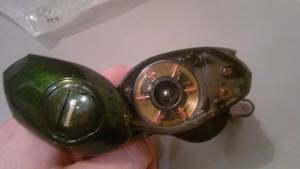
Prominent representatives of this “clan” are the companies Shimano and AbuGarcia (other companies are constantly trying to keep up with the leaders, so we simply will not take them into account), as well as the overwhelming number of users of such reels.
The centrifugal system is a device in a multiplier reel designed to dampen the excessive rotation speed of the spool when casting. It consists of two parts - located on the axis of the centrifuge spool (which, in turn, represents a system of fastenings and centrifugal guides on which removable weights are installed) and a brake cup (usually located in the removable reel cover). Under the influence of centrifugal force, when the spool unwinds, the weights move along the guides and come into contact with the walls of the brake cup.
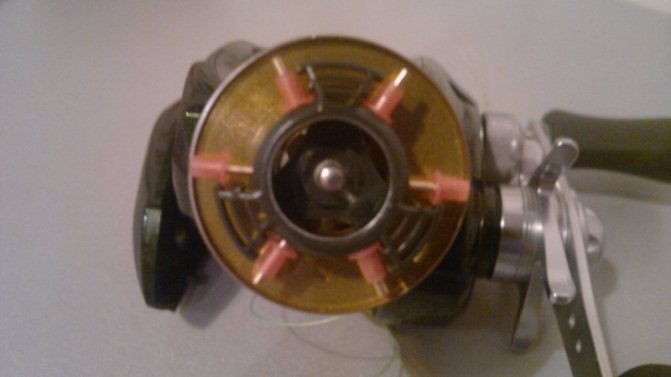
“Included” are 2 weights.
The braking effect increases in proportion to the speed of rotation of the spool and, accordingly, dampens it more strongly. It is precisely because of this feature that the centrifugal brake is more suitable for casting sailing baits, since their flight speed is significantly lower than the flight speed of compact ones. In some cases, the centrifuge allows sailing baits to fly even further than jig rigs of equal weight. All this happens because the compact bait immediately gives the spool greater inertia, and the centrifugal brake harshly extinguishes it - the bait very quickly loses speed and does not fly far. Let's take a wobbler for comparison - the initial flight speed of a sailing bait is lower than that of a compact one. And the lower the flight speed, the less the braking effect. Consequently, the braking dynamics of a sailing bait are much lower, so it flies further. Ugh! Looks like I formulated it correctly!
Now about the types of centrifuges.
There are systems with removable weights, and others with switchable weights (you can remove the weights to replace them with others of different weights, but it is strongly not recommended to work with removed weights).
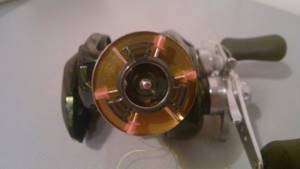
If you remove some of the weights completely, the acceleration of the reel will not be balanced, and, as a result, premature wear of the bearings and spool axis.
They differ in one thing - a two-stage stopper (if you see it at least once, you’ll immediately understand which is which). It is recommended to remove/disconnect/change to lighter weights in pairs or in threes (if there are six weights). During this operation, opposing weights should be used to maintain rotational symmetry.

Centrifugal brakes on multipliers are also available with internal and external adjustment. In order to adjust the braking force of a reel with an external regulator, just turn the lever on the removable cover - the weights will turn on/off automatically. To adjust the centrifuge with an internal structure, you will have to remove the side cover of the coil. There is no need to be afraid of this process, because the adjustment is carried out quite quickly and you know exactly how many weights are included on your reel. Just remember to turn the lid latch when you return the lid itself to its place. Otherwise, when casting, the lid will open and the spool will quickly fly out of the reel, wrapping everything around it (line, dirt, leaves). At the same time as the spool, words will come out of you that even adults might be afraid of, not like children!

When working with a reel with a centrifugal brake, first turn on all the weights, then, as the reel units heat up, turn off opposite weights in pairs - you will immediately feel the difference in casting range, despite the ridiculousness of the weights themselves.
By the way, about weights. The word “weight” is perceived by the fisherman as something leaden, although small, but heavy. When you open a reel with a centrifuge, it’s hard to call those multi-colored plastic pieces that are there weights. And the flight range of the bait depends on this garbage? Yes, it is these plastic cups, which also come in different weights (and different colors), that determine the casting distance. A natural question arises: “Why?” My answer is that a multi is a high-precision instrument, and changing the weight of a pair of weights by hundredths of a gram greatly affects the operation of the mechanism as a whole.

Well, as always, manufacturers are trying to outdo each other in developing and releasing more advanced centrifugal braking systems. Shimano surprises anglers all over the world with the SVS, 4x4 SVS, 8-point BFS braking system, SVS Infinite and some others. They are all slightly different from each other, but not fundamentally. The Abu Garcia company came up with the abbreviation IVCB-IV (Infinitely Variable Centrifugal Brake) for its special centrifugals and is very proud of its invention. The Daiwa company produces only classic large multipliers for the centrifugal system, so it takes a more modest position in this aspect. But despite this, they surprised casting fishing fans with a unique system - the Centriflex mechanical touch brake.
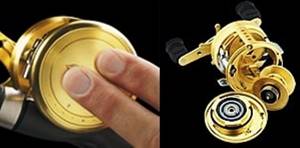
Centriflex system on Daiwa Luna.
Magnetic and centrifugal brakes in multiplier reels
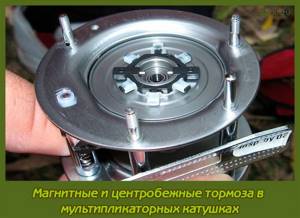
Why are magnetic brakes or centrifugal brakes needed in multiplier reels?
If you take a simple multiplier coil, you can immediately see that the structure contains a system of centrifugal weights or a magnetic system, i.e. There is a sequential sequence of magnets, which, approaching or moving away from the drum, slow down its rotation or, on the contrary, release it and make the movement of the drum more free.
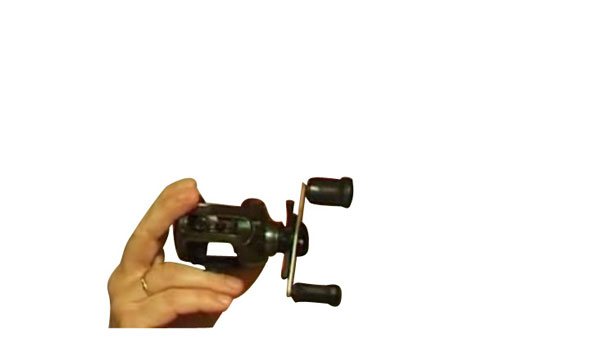
Rice. 25-6 These systems are designed to reduce the inertia of rotation of the reels at the initial moment of casting. What is the main difference between a multiplier reel and an inertial reel? If we make one drum with an inertial coil, and the revolution makes one revolution, i.e. The gear ratio of the inertial reel is one to one, then multiplier reels have from 2.5 to 6.3 full revolutions of the drum per revolution of the handle (Fig. 25-6). Thus, a multiplier coil turns out to be faster than, for example, a simple inertial coil, despite the fact that, in essence, it is not particularly different. And due to the fact that the gear ratio is high and the drum itself is small, at the moment of casting it rotates at high speed. And in order to suppress this speed, we need systems of centrifugal weights or magnetic brakes. Why do multipliers need a second braking system?
Let's open the coil and take a look. It has a magnetic or centrifugal brake, and the so-called mechanical brake is the second system that prevents the formation of a beard and eliminates troubles when fishing. For example, we fish with a simple inertial reel. At the moment of casting, at the initial stage, when the drum begins to rotate quite quickly, we lightly braked with our finger, slightly reduced the high speed of rotation of the drum, and at the time when the bait is about to touch the water, we need to easily slow down again finger, and the drum will stop rotating - the bait will touch the water. In multiplier systems, the function of the finger is performed by a mechanical brake.
We apply this brake, and at a time when the bait stops accelerating the drum, in other words, is at its end, it pulls the line less, and the mechanical brake begins to actively slow down the drum, i.e. At the final stage of casting, a mechanical brake operates in the multiplier reel. So, if at the initial stage of casting a centrifugal or magnetic brake operates, which slows down the rotation, making it more acceptable and uniform, then at the final stage of casting, when the bait is already at its end, a mechanical brake comes into effect, and a balance between mechanical brake, centrifugal or magnetic.

Rice. 25-7 If you set up the system perfectly, then it is possible to fish virtually without trouble, without any beards, especially if we fish with bait of the same weight.

Rice. 25-8 But in order to achieve a long casting distance, you should resort to all sorts of tricks.
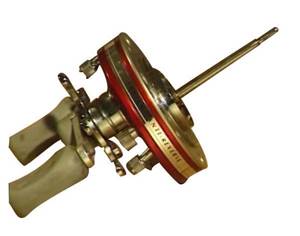
Rice. 25-9 at this point we will open the multiplier reel and demonstrate how centrifugal brakes are constructed (Figs. 25-7, 25-8, 25-9). For example, an automatic machine allows complete or incomplete disassembly. In most cases, multiplier reels allow incomplete disassembly, which we need for several reasons. Firstly, incomplete disassembly allows quicker access to the centrifugal or magnetic brake system. With magnetic brakes, in principle, everything is easy.
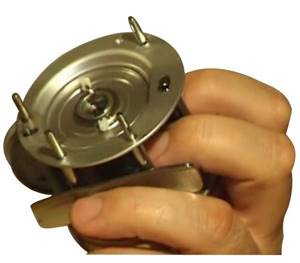
Rice. 25-10 And centrifugal brakes are a fairly unpretentious thing, but under certain conditions they can fail. If you want to cast over a long distance, you must take into account the presence of these brakes, and you need to use them skillfully (Fig. 25-10).
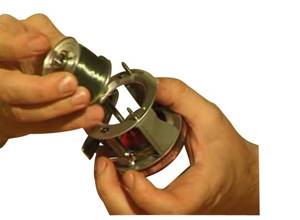
Rice. 25-11 How do centrifugal brakes work? I disconnected the main coil mechanism, i.e. The transmission ratio and the main gears and the reel mechanism are located in the housing shown in Fig. 25-8.
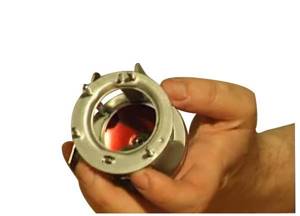
Rice. 25-12 The second part of the body is shown in Fig. 25-10, we will reach from there a domestic spool with a wound fishing line (Fig. 25-11, 25-12).
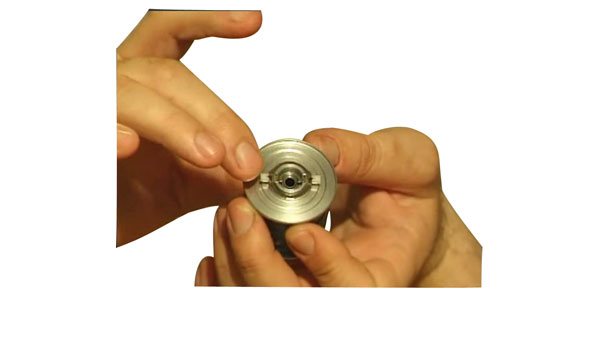
Rice. 25-13 The essence of centrifugal brakes is as follows: at the moment when we make a sharp cast, the initial speed of the drum is quite high, and in order to dampen this speed, the inertia of the weights shown in Fig. 25-13.
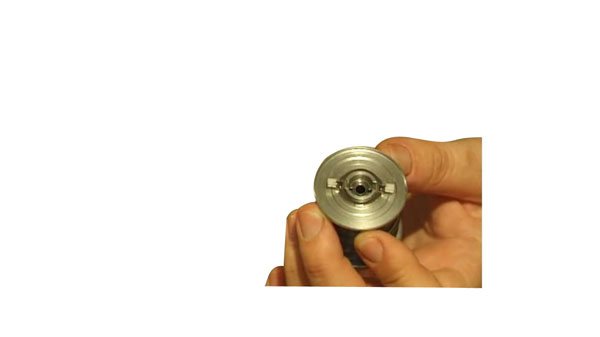
Rice. 25-14 Despite the fact that they are small, they have a certain inertia. They begin to move apart (Fig. 25-14). And the higher the speed, the more they diverge to the sides and put pressure on the glass.
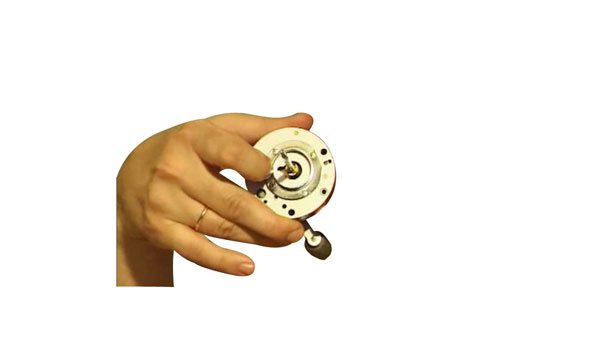
Rice. 25-15 They begin to press against the walls of this cup (Fig. 25-15), and thereby slow down the speed of rotation of the drum. When the speed drops, their inertia decreases significantly, and they stop slowing down so much. And then the drum rotates freely. And at the moment when the bait is about to touch the water, a mechanical brake comes into effect, or we ourselves slow down the bait with our finger and stop the drum. In order for this system to work perfectly, you should never allow grease or water to get on its surface.
So, if we are casting with a baitcasting reel in a downpour, or if water splashes from the braid or monofilament, microdroplets accidentally fall inside the mechanism, onto the system of this mechanical cup, and from there onto the brakes, and the brake stops working. It kind of presses, but due to sliding, the brake stops working as it should, as a result, line jumps appear, and at the moment of casting a beard appears.

Rice. 25-16 What should we do if we suddenly get beards at the initial stage of casting? We need to quickly disassemble the reel and thoroughly wipe the brakes, wipe the cup with a soft flannel cloth or napkin. And constantly try to prevent moisture or grease from getting into this system. The same can be said about a huge amount of lubricant getting onto the bearings. At the moment of very rapid rotation of the drum, this lubricant begins to splash and gets on the brakes.
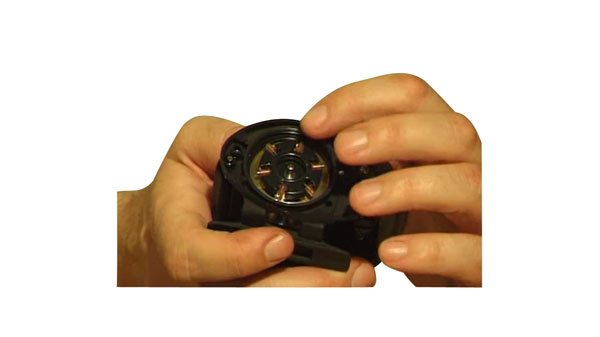
Rice. 25-17 The coil shown in Fig. 25-16, no longer has two centrifugal weights, but six. It is removed very easily, and we see the drum itself, on which six weights are installed (Fig. 25-17).
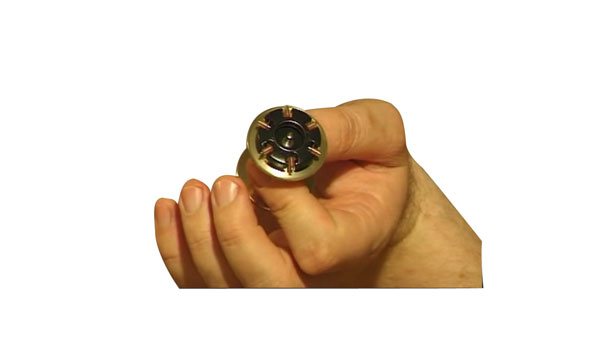
Rice. 25-18 Let's reach out to them and chat about them in detail and specifically (Fig. 25-18). The advantage of such a system is that we can very clearly adjust the degree of braking of the drum at the initial stage of casting, i.e. Whatever bait we use, we can very quickly change the system of these weights. They can be turned on and off. If you look at them close up (Fig. 25-19), you can see the latches on them. Initially we have two weights turned on and the rest latched. And at the moment of casting, only two diametrically opposed weights will be able to move along the axis.
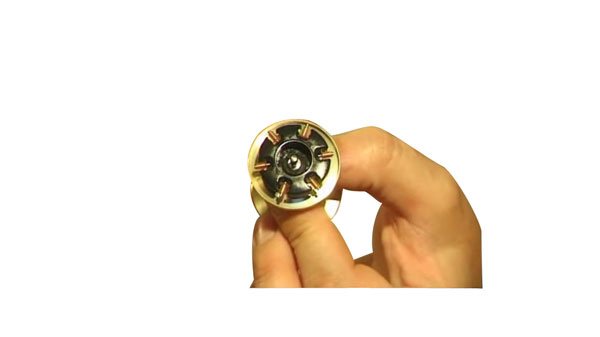
Rice. 25-19 If we suddenly have line runs, it is possible to disconnect a couple more weights and add one or two. You need to add symmetrically, in other words, opposite weights, and then the braking will be better. Perhaps, it goes without saying, turn on all 6 weights, and then there will be no line runs, but the casting range will suffer from this. We can leave two weights on, we can also turn off both weights at some point and perform the function of centrifugal weights using finger braking. We can leave only one centrifugal weight on.
So, if we want to achieve a long casting distance, we need to experiment with centrifugal weights - use one or several weights, or at some moments turn them all off. But if we want to achieve a long range, it is optimal to use one or two weights, and completely disable the mechanical brake, and use the finger to play the role of the mechanical brake. This is relative to the centrifugal brake system. Magnetic brakes work on the same principle. The magnets either approach or move away from the drum, due to which the rotation speed changes. Any multiplier has quick access to the spool, reel and centrifugal weights. Its essence lies in the fact that line jumps usually occur with a baitcasting reel.
And in order to untangle the beard, sometimes you have to get a spool. If you can’t reach it, it will be very difficult to untangle a competent beard. For example, we fish with a head weighing 15 grams, having the perfect settings for weight, and later decide to switch to a heavier head - say, weighing 25 grams. Of course, we need to slightly adjust the mechanical brake, turn on or off a pair of centrifugal weights, and work more actively with our fingers - for example, to slow down the bait at the end. This should be treated very lightly.
And you need to have some experience in order to avoid the formation of a beard. We took the drum out of the multiplier reel, now we need to put it back. We will not be able to assemble the multiplier because the weights may accidentally move apart, and while we are putting on the drum, we can damage the system of these weights with a glass. To prevent this from happening, you need to move them with your finger to the axis (center), and only then attach the second part of the coil. We connected it, tighten the bolts - and everything works for us.
Braking systems in multiplier reels
KastKing Stealth froze the spool!!! Super multiplier reel!!!
Magnetic brake
The antagonist of the centrifugal system is magnetic. Daiwa is firmly established on this side of the barricades. Sometimes Swedes also come to the magnet lovers' camp, but Abushka still has fewer magnets than centrifuges.
The magnetic braking system (in English spelling MAG) is a non-contact system for adjusting the rotation of the spool during casting, which uses the interaction of two physical phenomena: centrifugal force and magnetic field. Magnitogorsk, like a centrifuge, consists of two interacting parts - a magnetic cup and a magnetic block. Only in this braking system the magnetic cup is fixed on the spool, and the magnetic block is in the side cover of the reel. It is precisely because of this design feature that the magnetic system has only external adjustment.
At rest, the brake glass does not interact with the field of the magnetic block. When the spool begins to unwind, the centrifugal force moves the glass towards the magnets - and it falls into the zone of action of the magnetic field, which slows it down. As the rotation speed drops, the glass returns to its original position. A special switch with a scale limits the removal of the magnet system, resulting in varying degrees of braking.
The magnetic braking system has a wide range of adjustment for medium speeds, but is excessively braking at low speeds. At higher speeds, braking is less noticeable than with a centrifugal system, allowing for a higher initial speed. It is precisely because of this feature that a magnet is more suitable for long-distance casting with compact baits - jigs and Cheburashkas. This does not mean that a reel with such a system cannot be used as a wobbler. It’s possible, no one forbids it! Only the casting range, compared to a centrifugal reel, will be significantly lower.
When working with a coil with a magnetic braking system, you should initially set the switch to position 8 or 9 (10 is the maximum value). As the reel bearings warm up (5-10 casts), you can reduce the magnetic effect down to 2 or 3 units. Here it is important not to over-loosen the brake - to find your own line between the ever-increasing casting range and the moment of formation of dashes.
Well, “surprising things” from manufacturers - that goes without saying! Parents of the magnet, the Daiwa company first produced the MagForce system (improved Mag), then MagForce V (improved MagForce), and now they have reached Magforce 3D (has 3 operating modes - Max Brake, All-Around and Long Cast with very accurate settings within each mode). Abu Garcia? Although it produces few reels with magnetic brakes, it does it at the highest level, releasing the MagTrax system (according to reviews on the Internet, it is a very convenient system).
Types of baitcasting reel brakes
Choose baitcasting reels with at least 6 centrifugal weights or an equally powerful magnetic braking system
- magnetic
- centrifugal (centrifugal weights)
These two types of brakes allow you to slow down the rotation of the drum from the moment of rapid spin-up at the time of casting. If it weren’t for the brakes, the baitcasting reel drum would spin faster than the line coming off it - hence we would get a beard, tangling of the line.
Magnetic braking works by stopping a spool that is spinning too quickly at an early stage using small magnets. Both this type of braking and centrifugal have to be adjusted manually depending on what weight of bait you are using.
centrifugal braking - small weights protrude from the center and can move from the center of the reel to the edges. When the reel rotates too quickly due to centrifugal force, they come out and begin to rub a special partition, due to this, braking occurs at excessive speed at the initial stage of casting.
A mechanical brake is a manual type of brake (absolutely all reels have it), which should be used already at the end of the bait, when it touches the water. Due to the mechanical brake, the multiplier reel reacts to weak line release from the reel and brakes the drum in the most effective way for long casting.
The disadvantage of a multiplier reel is that when fishing with a bait of the same weight (for example, a 15 g jig head), we need to set the same settings for the centrifugal weights or magnets and adjust the mechanical brake. But as soon as we put the bait in 25 g, the previous number of centrifugal weights will no longer cope with the primary braking, we will have to include additional weights in the work and be prepared that the casting range may suffer.
Choose multiplier reels with at least 6 centrifugal or magnetic weights, this will allow you to more accurately adjust the primary braking and successfully fish at long distances.
How to set up a baitcasting reel for proper braking
If you are a beginner, start fishing with centrifugal or magnetic brakes set to maximum, and only when you see that the brakes are too large, turn off one pair of weights at a time. This will prevent the appearance of a beard when casting. Successful casting with a baitcasting reel comes with experience.
Centromagnets
What could be easier to end more than a century of confrontation between the warring parties than to reach a compromise. But not everything turned out to be so simple - many companies tried and still combine (probably haven’t learned yet) magnetic and centrifugal braking systems in their reels in the hope of getting the best from each of them.
Only the initially desired one and a half times increase in casting range, obtained due to the advantages of the centrifugal system at low speeds and the magnetic system at high speeds, is not achieved to the extent that we would like. At high speeds, the centrifuge, despite the presence of magnets, “cuts” the speed (a little less, of course, but cuts), and at low speeds the magnets excessively anchor the spool (well, they cannot be switched off completely) with almost complete inactivity of centrifugal forces. Yes, there is an increase in range, but, as a rule, it is not very large.
Anyone who is interested in buying such a reel needs to determine for themselves whether such a reel is needed and whether it will ideally perform the tasks assigned to it.
Among the perverted inventors was Abu Garcia with its Ambassadeur S 3000 C reel, as well as the new Revo STX. Smaller and less famous multi-reel manufacturers periodically throw similar products onto the market.
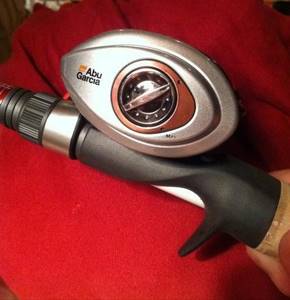
Of course, progress does not stand still, and the problem of coexistence of opposing braking systems will sooner or later be resolved. Or maybe they'll come up with something more effective? I think they've already figured it out! And the entire advanced fishing world has already recognized this.
DC system
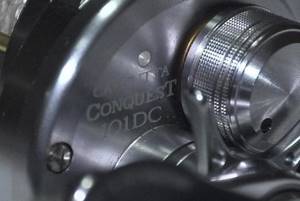
The smart DC (Digital Control) system is likely to change the balance of power in the mechanical braking wars in the near future.
The first and only manufacturer of reels with a DC system is the Japanese company Shimano, a leader not only in the production of baitcasting reels as such, but also in the production of electronic systems in particular. The idea of producing an electronic braking mechanism hovered in the minds of Shimanov engineers for a long time, but it was first embodied in electronic brakes for bicycles. An electronic braking system for multipliers appeared back in 2003 with the release of the Calcutta TE DC reel.
The appearance of this innovative product initially caused skeptical reviews from casting fishing followers around the world, saying that electronics do not last forever, but mechanics are more reliable, the centrifuge wets and dries, but what about the electronic mechanism. But after the first tests, the negative feedback from anglers gave way to admiration - the electronics worked almost flawlessly, and even the mechanism turned out to be truly waterproof. The coil was deliberately immersed in salt water for a long time, after which it continued to work without changes.
Here's what Shimano writes about this in its advertising brochures (translation):
The waterproof Digital Control system is self-charging. It stores energy on every bait cast and does not require an external power source. During the casting process, the rotational energy of the spool is accumulated in a special printed circuit board of the DC system and powers the Digital Braking system on subsequent casts. The DC system's programmed braking patterns allow the spool to reach maximum rotation speeds before the electronic brake is engaged, whereas traditional systems (centrifugal and magnetic) begin braking from the first second of the cast and do not allow the spool to gain speed. Spools, in reels with generally accepted braking systems, operate at speeds in the range of 15-20 thousand revolutions per minute. With the use of digital braking technology, the spool rotation speed often exceeds 30 thousand revolutions per minute (a speed increase of 50-70%). At the same time, DC perfectly controls the line throughout the cast, allowing it to be cast longer and more accurately. In real fishing, the average casting distance with the DC system increases by 20-40% compared to classic braking systems. The digital control program contains 8 braking patterns, switching between which occurs through external adjustment. DC gives the angler excellent control throughout the cast by adjusting the drag force in 1/1000th of a second increments. The use of “smart” braking technology using the DCBS (Digital Control Braking System) system almost instantly stabilizes the spool rotation speed. The system optimizes the braking force applied to the spool, thereby minimizing the formation of skips. As a result of the system's operation, any angler can get a long and accurate cast without worrying about the appearance of dashes.
The digital system is especially effective when working with light sailing baits - light wobblers and unloaded rubber.
There are many positive reviews on the Internet regarding the use of coils with a DC system. Today it uses several varieties of the Digital Control system in its reels. They can be divided (but only conditionally) into simpler and more complex.
So what are these 8 different modes that work so perfectly in all conditions? Let's get a look. In fact, there are only 4 operating modes, which work with two types of fishing lines - monofilament (and with them fluorocarbon) and braided. So it turns out that there are 8 modes.
- I - L - long cast. The maximum casting distance for heavy equipment is achieved with relatively little wind.
- I - A - provides long casting with minimal effort. The braking weakens towards the end of the bait's flight.
- I - M - a little more braking for power casting.
- I - W - for casting light baits in strong winds. This mode is ideal for working with wobblers.
The cost difference achieved with a digital control system ranges from $200 to $250 for mid-range reels.
Although this price cannot be called average, you have to pay for technology! So it’s up to you, dear friends, to decide whether you need such a system or not. I personally decided for myself that, when the opportunity arises, I will definitely try out this miracle of engineering and, perhaps, even buy it.
A few words in favor of cartoonists
The design of multipliers is much simpler than that of inertialess reels, in which the number of elements can reach up to a hundred, as we wrote about in the article “How to use a multiplier reel for spinning and its principle of operation.” But even in this case, it requires quite careful handling and care. Do not allow it to get into water, but if this cannot be avoided, the reel must be opened and thoroughly cleaned.
- Quite often you can hear that you need to choose only an expensive reel, since cheap ones do not work well. In fact, this is not true, 80 percent of Americans use multis starting at $50.
- Fishermen are alarmed by the fact that after almost every fishing trip it is necessary to do maintenance. This is not true, the multiplier works perfectly throughout the entire fishing season, the exception is if it gurgles into the water.
- A lot of articles have been written about casting gear with a baitcaster, after reading which you begin to realize how difficult it is to cast with such a reel. In fact, everything is exactly the opposite. The main thing is to adjust the brake to the bait that will be used for fishing.
- A form for a multiplier can only be expensive. The statement is not entirely true; sensitivity is more determined by the reel and tactile transmission to the angler’s hand.
- The thread can be used of any cross-section, and this will not affect the range of the tackle.
- The fear of cartoons can be caused by another factor - the formation of beards. With sufficient skill, it is not difficult to avoid this, and unraveling the knot is often quite simple.
At fishing competitions, athletes prefer to work with multiplier reels that are capable of making long casts while accurately targeting the fishing spot. Modern cartoons are equipped with handles on both the left and right sides.
Adjusting the multiplier reel brakes
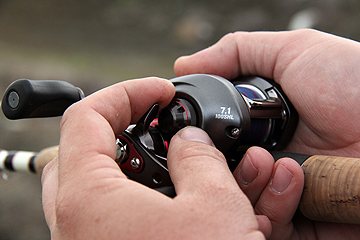
It often happens to an inexperienced fisherman that the cast fails and the line comes off more than necessary, the excess of which gets tangled and forms a beard. This is characterized by several factors:
- lack of bait casting skills or experience with another type of reel;
- incorrectly adjusted friction brakes of the multiplier;
- incorrectly selected equipment, for example, the cross-section of the line is larger than that indicated on the reel marking.
The first brake mechanism controls the rotation speed of the spool during casting. That is, the fisherman, sending the bait forward, causes the drum to rotate at a high speed, which can overtake the line. The inter-axial braking system stops the drum after splashing down the equipment, when the bait has already stopped and the spool is still rotating.
For successful fishing, it is enough to set the brakes once. The mechanical brake is set to half the force and then, during fishing, is adjusted more precisely depending on how the animator behaves. The magnetic brake is adjusted so that when the bait comes into contact with the pond, the drum makes one revolution.
Clicker
This incomprehensible English (or maybe American) word is used in cartoons to describe the “ratchet”, which is familiar to the Russian ear.
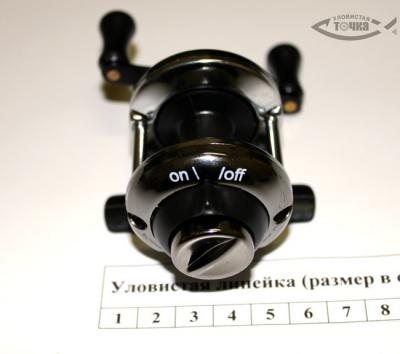
The usual line-off indicator in baitcasting reels also serves as an auxiliary brake. This is nothing more than an analogue of the batrunner system installed on inertia-free vehicles. Many people are familiar with the work of a batrunner, and this article is about cartoons, so I won’t talk about this, after all, braking system. I can only say that it is turned on by a special key or switch on the side panel of the case and releases the spool from the main brake.
The clicker is especially useful for trolling fishing, as well as vertical fishing, as a bite or hook indicator. In general, this fisherman's friend helps extend the life of the reel by helping to avoid sudden loads on the main components of the multiplier.
Many users of clicker reels say that using such a mechanism is nothing more than “show-off”. But carp fishers will fundamentally disagree with this statement (I hope).
Multiplier reels. Structure and design
All cartoon models consist of a box with a reel inside. The handle is on one side and controls, for example, the release button (or lever), and the controls are located on the other side panel. Rotation occurs on the spindle. They are usually attached to a rod with a movable seat, although metal mounts similar to clamps are also commonly used.
It is also worth noting here that one fixed coil can be either left-handed or right-handed. The cartoon one is distinguished by a handle built into one side, the position of which cannot be changed, which means that it is worth initially buying a convenient option.
Typically the reel must be paired with the correct type of rod. Rods designed for multiplier reels have a greater number of smaller rod rings compared to rods designed for fixed reel applications. However, it is increasingly common to see manufacturers releasing options that can be used with either a multiplier or fixed reels.







